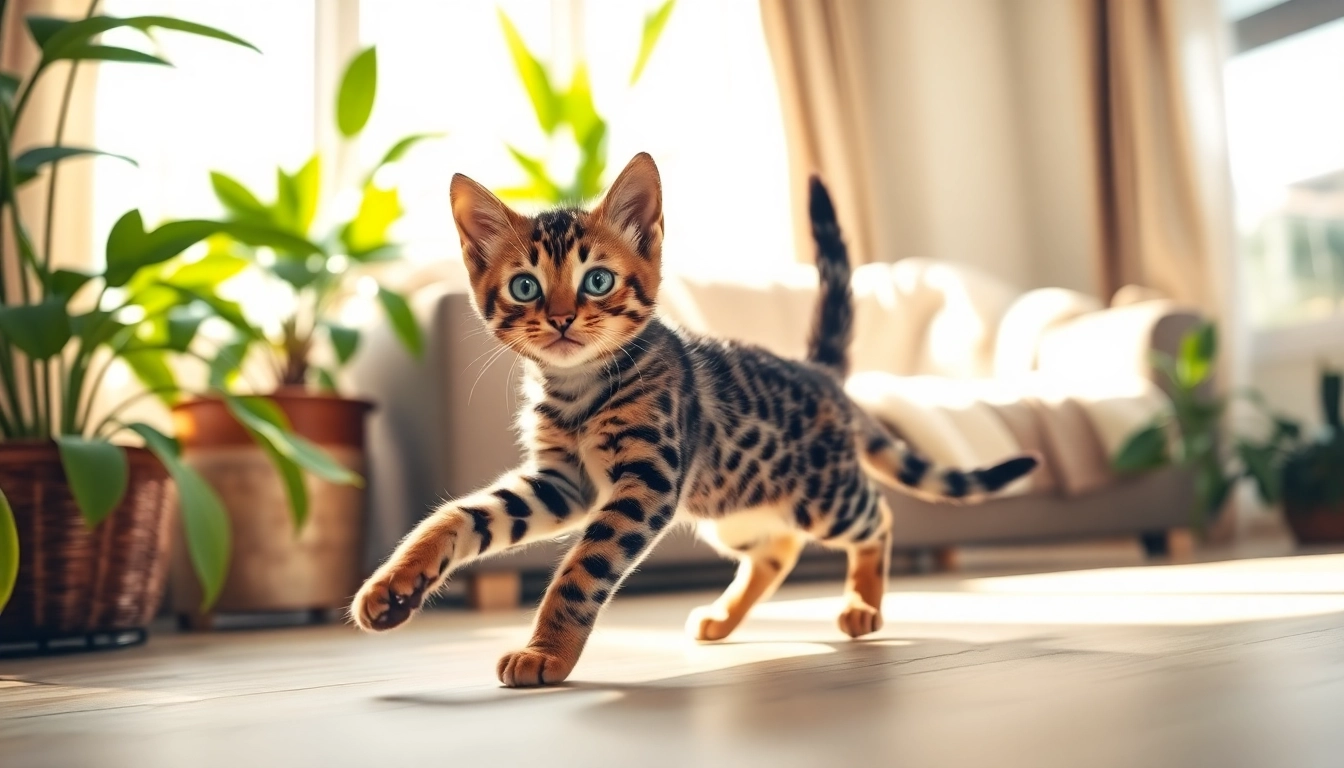Understanding the Bengal Breed
History and Origin of Bengals
The Bengal breed originated from a cross between domestic cats and the Asian leopard cat in the late 20th century. This intentional hybridization led to a striking breed that melds the wild beauty of a leopard with the gentle disposition of a domestic cat. The first Bengal was developed by Jean S. Mill, a breeder who recognized the potential of these exotic-looking cats. Since then, Bengals have gained popularity due to their captivating appearance and lively personalities. They are now recognized by various cat registries, including The International Cat Association (TICA), which has been pivotal in standardizing and promoting the breed.
Physical Characteristics of Bengal Cats
Bengal cats are renowned for their stunning visual aesthetics, characterized by their unique coat patterns, which range from rosettes similar to those of a leopard to marbling resembling that of a wild cat. Their muscular and elegant frame, coupled with large, expressive eyes, creates a dynamic presence that is hard to resist. Adult Bengals typically weigh between 8 to 15 pounds, with females generally being smaller than males. Their fur, which is short and soft, has a luxurious feel, and it often exhibits a striking glitter effect under light, enhancing their already extraordinary appearance.
Temperament and Behavior Traits
The temperament of Bengal cats is an intriguing aspect of their appeal. Known for being highly energetic and intelligent, these cats require ample mental stimulation and physical activity. Bengals enjoy interactive play and often exhibit dog-like behavior in their affections towards their owners. They are vocal and curious, making them engaging companions, though they can also be quite mischievous. This breed thrives in environments where they can explore and climb, so providing stimulating toys and opportunities for exercise is essential for their happiness and well-being.
Why Choose Bengal Breeders in Orange County
Local Breeders and Their Unique Offerings
When considering a Bengal cat, opting for local Bengal breeders in Orange County presents several advantages. Local breeders often have a deep understanding of the breed’s history and characteristics specific to the region. They may also have established reputations within the community, fostering trust and credibility. Moreover, many local catteries focus on responsible breeding practices, ensuring the health and temperament of their kittens. Potential owners can benefit from personal interactions, allowing them to meet the kittens’ parents and understand their breeding environment.
Benefits of Buying Locally
Purchasing from local Bengal breeders can make the transition smoother for both the cat and the owner. Eliminating the stress of long-distance travel, a local purchase allows for direct interaction and an opportunity to gauge the socialization and care of the kittens firsthand. Owning a cat from a nearby breeder also allows for ongoing support, as many breeders are happy to provide advice and assistance even after the sale. Additionally, health checks and initial vaccinations often accompany local purchases, ensuring that owners start on the right foot with their new feline family member.
Health Guarantees and Support
Responsible breeders in Orange County prioritize the health of their kittens by conducting thorough health screenings for potential genetic issues common in Bengal cats, such as Hypertrophic Cardiomyopathy (HCM) and progressive retinal atrophy (PRA). Many breeders offer health guarantees that provide peace of mind for prospective owners. This assurance often includes conditions under which the buyer can return the cat or receive financial support for medical issues that might arise early in the cat’s life. Moreover, the ongoing support from breeders can guide owners through the first few critical months, answering questions about diet, training, and behavioral concerns.
What to Look for in a Bengal Breeder
Key Questions to Ask Breeders
When selecting a Bengal breeder, it’s crucial to ask pertinent questions that can help you gauge their commitment to quality and ethical breeding practices. Essential inquiries include:
- What health testing do you conduct on your breeding cats?
- Can you provide references or testimonials from past buyers?
- What kind of socialization do your kittens receive before going to their new homes?
- Are your cats TICA registered, and do they follow the breed standards set forth by the organization?
- What support do you offer after the purchase of a kitten?
Red Flags to Watch For
While many breeders are dedicated to their craft, not all are ethical. Be alert for warning signs that indicate a breeder might not prioritize the welfare of their cats. Red flags include:
- Lack of transparency or inability to provide health documentation of breeding animals.
- Overcrowded living conditions where cats are not adequately cared for.
- Undefined health guarantees or overly restrictive contracts.
- Reluctance to allow you to meet the breeding cats or to see their living conditions.
Importance of Breeder Certifications and Registrations
Breeder certifications from reputable organizations, such as TICA, are indicators of a breeder’s commitment to ethical practices. Registered breeders adhere to standards that promote the health and well-being of their cats. These certifications often require rigorous documentation of health tests and breeding practices, giving buyers more confidence in their purchase. When considering a breeder, it’s advisable to verify their registration status and understand what types of testing their breeding cats undergo.
Bringing Home Your Bengal Kitten
Preparing Your Home for a New Kitten
Before welcoming your new Bengal kitten home, it’s essential to ensure your environment is safe and welcoming. Here are some tips for creating a suitable space:
- Secure hazardous areas: Bengals are curious explorers; ensure that toxic plants, cables, and small objects are out of reach.
- Designate a space: Set up a cozy area with a bed, litter box, scratching post, and toys to let your cat acclimate comfortably.
- Introduce gradual: Allow your new kitty to explore their designated space at their own pace before opening up the rest of the house.
Initial Care and Diet Recommendations
The first few weeks with your Bengal are crucial for their adjustment. Proper nutrition and care contribute significantly to their overall health. Transition your kitten gradually to the diet they will primarily consume. High-quality, protein-rich food is essential for growth and development.
Consult with your veterinarian to create a meal plan adjusted for your kitten’s age, size, and health needs. Regular vet visits are crucial in the early stages to monitor their health and keep up with vaccinations.
Building a Bond with Your Bengal
Building a relationship with your Bengal kitten takes time and patience. Regular interactive play is essential to establish trust and strengthen your bond. Bengals are intelligent and adventurous, so engaging in activities that challenge their minds, such as puzzle toys and training sessions, can enhance your connection. Spending quality time together while playing and exploring will foster a deeper relationship, ensuring a fulfilling companionship.
Common Challenges and Solutions for Bengal Owners
Understanding Health Issues in Bengals
Bengal cats are prone to certain health issues due to their genetic makeup. Among the most common is Hypertrophic Cardiomyopathy (HCM), a condition that causes thickening of the heart muscles. Regular check-ups with a veterinarian familiar with the breed can help monitor potential issues. Additionally, responsible breeding practices can mitigate these risks, making it essential to choose a reputable breeder.
Behavioral Issues and Training Tips
Bengals, given their energetic nature, can exhibit behavioral issues, including excessive scratching, jumping, or meowing. Starting with early training is vital to curbing undesirable behaviors. Positive reinforcement techniques, such as rewarding desired behaviors with treats or praise, can facilitate effective training. Regular play and exercise can also prevent boredom, which often leads to behavioral problems.
Finding Community Resources and Support
Connecting with a community can enrich your experience as a Bengal owner. Look for local cat clubs, online forums, and social media groups where you can share experiences, ask questions, and receive support. Here, you can find resources from fellow Bengal enthusiasts, including training tips, health advice, and recommendations for veterinarians who specialize in breed-specific care.













Leave a Reply